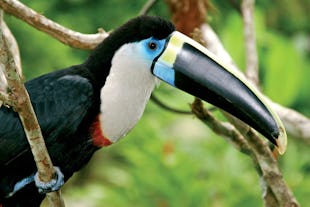
Peru Wildlife Guide
Immerse yourself in their world



Andean legend has it that god Viracocha emerged from Lake Titicaca to create the sun (Inti) and moon (Killa), who later commended their two children to found an empire in Inti’s honour: thus was born the Inca empire! Sitting pretty at 3,800 metres above sea level, this is the highest navigable lake in the world and the largest lake in South America, its vastness a reflection of the amount of culture and history it packs. Setting out to explore the lake you’ll discover the unique livelihoods of the Uros, who will welcome you onto their floating island homes, and meet the amazing dwellers of Taquile, whose weaving skills are simply out of this world. The Titicaca gold and blue landscapes are a constant feast for the eyes, while back on dry land the monumental chullpas at Sillustani archaeological site are worth the visit - and come with a stunning view of their own.
Start with a recommended trip or create one from scratch
Sitting at over 3,800 metres-above-sea-level, Lake Titicaca is the highest navigable lake on Earth. Scattered across the water, there are over 60 floating islands built by their residents, the Uru people. Spend time with this incredible community who live mostly technology-free, enjoying a ride in one of their reed boats and learning how the islands were built and now sustained. Then, explore the waters at your own pace by kayak, stopping off at the tiny islands along the way, and end the day with a sunset sail.
As touristy as visiting a couple of the islands might feel, exploring Lake Titicaca is an eye-opening experience as you learn about the unique cultures and get to know the inhabitants.
For a more authentic cultural experience, spend the night at a local house on Amantani island - its location further away from the mainland means less tourists! Or try something you’d probably never have thought of: row a Polynesian outrigger canoe on the lake.
As blissfully sunny as it is during the day, keep in mind Puno is pretty high up in the Andes - as soon as the sun goes down, temperatures start falling closer to freezing. Whichever season you decide to visit in, the answer is in the layering.
Jan
Feb
Mar
Apr
May
Jun
Jul
Aug
Sep
Oct
Nov
Dec
Wet Season
Wet Season
Wet Season
Wet Season
Dry Season
Dry Season
Dry Season
Dry Season
Dry Season
Dry Season
Wet Season
Wet Season